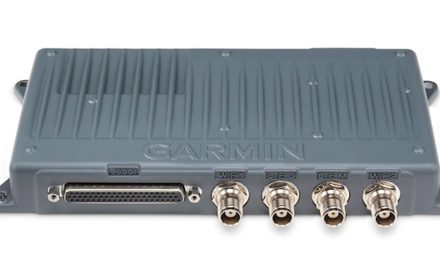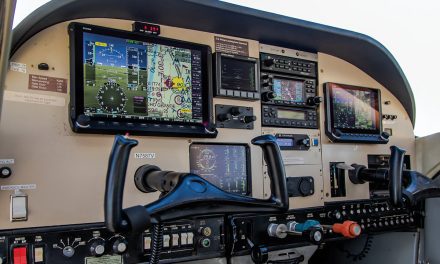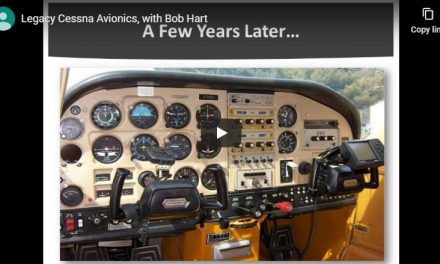What Most Pre-Purchase Inspections Won’t Tell You about Avionics
By Bob Hart – www.AvionixHelp.com
The above headline sounds like a promotion from one of those mega avionics shops or aviation dealers, but it’s not. Actually, it’s supposed to be the other way around: You buy an airplane and you get the avionics panel included in the deal.
Fact is, when we buy an airplane, we have a bad habit of taking the latter, the avionics, for granted. In 1990, you could buy a decent airplane, panel and all, for the cost of a reasonably updated avionics panel by today’s standards. Today, the avionics alone is worth what the whole airplane was worth 20 years ago. In this discussion, we talk about the dangers of skipping the avionics when doing a pre-purchase inspection.
Consider this fictional, though all-too-likely, scenario and see if you recognize it:
Tom Pilot has been flying around with a fresh private ticket and has been renting for a few years. He’s 20 percent into his instrument rating and has been saving up and shopping the used airplane market. He’s ready to spend $80,000 on his first airplane—that is his budget. He’s online and tapping Trade-a-Plane every chance he gets. Finally, he finds a 1985 Cessna Skylane for sale from a private seller just 100 miles away. It has beautiful new paint (in Tom’s favorite colors!), a nice interior, and a low-time rebuilt engine. Even his wife, a bit of a “reluctant” flyer, seems to like it! It’s got a complete avionics package that his instructor says will be okay for the rest of his IFR training.
A week ago, he and his wife flew up to look at it. First impressions were good, but today, he, his flight instructor, and the local mechanic will fly up, take a better look, and, if so agreed, leave a deposit. Tom’s done his homework. He found someone to finance a good portion of the plane and he has a competitive insurance quote in hand. He thinks he knows what the airplane will cost (including hanger fees, etc.) and hopes things like annuals and maintenance will be kind to his budget. The wife, although she likes the plane, is nervous about aircraft ownership.
Tom picks up the keys to a rented 172 and they’re off. When they arrive, the Skylane is all washed (except for the belly?) and is ready for its inspection. Tom and his instructor focus on the airframe while the mechanic looks over the engine compartment and briefly checks the logbooks. They like it.
With the owner’s approval, the four of them take the Skylane for a brief flight around the area. Tom’s instructor makes a call on both Nav-Coms to the local Unicom and tunes in the local VOR and everything seems okay. The aircraft has a Garmin GNS-430 and an updated audio panel. The GPS is showing their position and the transponder is flashing from time to time indicating that it’s doing its thing. The autopilot keeps the wings level and is holding heading okay. Tom makes a nice first landing and with a handshake and a check, the die is cast. It’s agreed that the owner will deliver the airplane next Saturday and a more thorough “pre-purchase inspection” will be done at that time prior to the official exchange of ownership.
They fly home and Tom can barely concentrate on flying the 172. They almost wander into a control zone halfway home, but manage to skirt the airspace without incident. As you can imagine, Tom’s seeing a lifelong dream come to fruition and he’s feeling like a kid on Christmas. I know the feeling and that smile. I still have a photo of me on Christmas morning at about 6 years old holding a die-cast P47 with the folding wings, landing gear, and spinning propeller. You can see that same smile, right now on Tom’s face. It’s a very exciting and emotional time for a pilot.
Finally, the big day arrives and the Skylane has arrived and is pushed back into the mechanics hangar. Tom stands back and the mechanic and his instructor do their thing. The instructor is searching FAA data on the Skylane for ADs and service bulletins while the mechanic opens inspection ports and takes a good look at the internal workings of the aircraft. Later, he will do a compression test and a thorough inspection of the prop and the logbooks for previous damage. Two hours later, other than a few minor discrepancies, the Skylane is given a clean bill of health and the deal is done. The instructor flies the old owner back to his home airport in the rented 172 and the family arrives to see the new airplane and possibly take a first ride. Tom is beaming, but the weather is not—the first family flight will have to wait until another time. Tom tucks his new Skylane away in the newly rented hanger and the experience of aircraft ownership begins!
I think you’d agree that the above scenario is representative of many used airplane transactions. I’ve owned six planes over the years and this pretty much describes the process for me. The above scenario is, of course, fiction, but what about reality?
Here are a couple of real scenarios that I recently came across from my involvement in the avionics forums and through my consultant business:
Scenario 1 – Russell B. recently bought a 1978 Piper Lance with an upgraded avionics panel that included a Garmin GNS-530W and 430W. It was time for him to update the data cards in both units when he discovered that the GNS-430 was not a WAAS unit and that the serial number was different from that recorded in the logbook. Of course, the aircraft was advertised as having WAAS units, and the aircraft broker who sold him the airplane offered no insight or knowledge of the situation. It was suggested that, at some time, the GNS-430W must have been stolen and replaced with the non-WAAS unit. This is actually a somewhat common scenario. The crook breaks into your airplane, removes your avionics, and replaces it with another like unit (probably also stolen). Since you don’t see the change, you don’t report the serial number as stolen. You now have a stolen radio in your airplane and the crook has a radio that was not reported or gets reported months or even years later. However, this scenario does not seem to apply to Russ. At the time the radios were switched, the WAAS antenna was removed and the non-WAAS antenna that works with the standard GNS-430 was installed! An avionics “crook” operating in the shadow of darkness seldom has the time or interest in an antenna changout. Unfortunately, Russ has little recourse now. He can, if he chooses, upgrade his GNS-430 to a 430W unit—but at a cost of about $4000.
Scenario 2 – Brant P. bought his 1982 Piper Turbo Saratoga in 2009. The airplane came with a few upgrades to the factory-installed avionics and he contacted me for advice on some of the avionics issues he was having. After a lengthy discussion, which included a review of his existing avionics, we developed a few options for avionics panel upgrades to get the Saratoga up to the capability he wanted. (Note: I always start with an assessment of existing avionics to see what we might keep. I then build an upgrade around that information.) If you’ve been following my avionics articles, specifically regarding Traffic Avoidance, you know that I believe that the only “safe” defense against a mid-air collision is an “active” traffic system. Brant’s Saratoga, when he bought it, was advertised as having active traffic, which was good and certainly something we would want to keep. Unfortunately, it turned out that the traffic unit he had on board was a passive unit and of minimum value. The cost (through Avidyne) to upgrade to active traffic, consistent with the kind of flying that Brant will do with his Turbo Saratoga, will be about $4000.
No one likes surprises. When you purchase an aircraft, you want to know that you’re getting what you paid for!
So much for reality—let’s check back in with Tom Pilot to see how he’s doing with his “new” Skylane a few months later.
Tom and the family have had their first flight together—and a few more since then. He’s also continued working with his instructor towards his instrument ticket. On his second lesson in the Skylane, they traveled to a larger airport to practice instrument landings on the ILS. En route, the GNS-430 would shut off on its own and come back on a little later. This hadn’t happened on the short flights with his family. After checking for a wiring short or something simple, a call to Garmin suggested the problem was with the radio. $1000 later, the radio is repaired and working fine. Unfortunately, when the Garmin went down, Tom also discovered that the #2 Nav-Com, a KX-155, had very short range on transmit. The diagnosis seems to be either a bad antenna or cable or a weak transmitter board in the radio. This problem hasn’t been solved yet, but it’s likely to be at least $300 if the problem is in the aircraft or more than double that if the problem is in the radio. Tom’s better half is not happy! To make matters a little worse, the directional gyro, which drives the heading bug on his Century IIB autopilot, is precessing badly and requires constant attention in flight. It will need to be rebuilt at a cost of about $800-1000! The good news is the engine is running great and the paint is still shiny!
The fact is, the above scenarios could have been avoided, or at least minimized, if the pilots of all three airplanes had taken the time and spent a few dollars to have the avionics evaluated before purchase. First, let me confess that I too have been guilty of this. My six airplanes where all bought before I got into the avionics business in 1997. When I bought my airplanes, I was concerned about engine and airframe time, who did the engine overhaul, the condition of the paint and interior, and the feedback from the mechanic (not an avionics guy) who did the pre-purchase inspection. I assumed that since the avionics performed what appeared to be okay during the test flight, that they were okay. In other words, I undervalued the portion of the aircraft that was the avionics and instruments.
As I recall, I was pretty lucky and avoided any major issues. However, in the real cases of Russ and Brant, both will need to spend about $4000—just to get what they already paid for! As for Tom, our make-believe pilot, he’ll have to spend more than $2500 in “make-believe” money to solve his avionics problems. This, of course, was not in his $80,000 budget. Plus, Tom also has that other problem—a wife who thinks that aircraft ownership stinks!
So, how can these scenarios, and others like them, be avoided?
The solution is relatively simple:
When you purchase an airplane, take the avionics as seriously as the engine and have BOTH evaluated by a qualified professional before you hand over the check.
Evaluate the engine and airframe first. Schedule a pre-purchase inspection of the engine and airframe with a qualified mechanic—preferably one who has knowledge and experience with your aircraft model and who is independent of the seller. Then, if the aircraft passes that inspection, schedule an avionics evaluation with a qualified avionics shop. Inspect the avionics to make sure you’re getting what’s advertised AND that they’re operating as they should. If you do your homework, you can often find one facility that offers both services in one hanger.
Surprisingly, while all avionics shops can do inspections, many don’t promote it. One avionics shop that really does it right is CE Avionics (www.ceavionics.com) in Sanford, Florida. In fact, avionics inspections are something they do quite frequently. They use a 10-12-page checklist to ensure a thorough avionics evaluation. When they’re done, you know exactly what you’re buying and in the event of a discrepancy you can use that information to negotiate with the seller. CE also offers an added convenience that few other avionics shops can provide—a mobile fleet of service vans that can do the inspections on-site. Plus, if an autopilot problem is detected, they’re super-qualified to address most autopilot issues as well.
A pre-purchase avionics inspection by CE in Tom’s Skylane would’ve been a very affordable 2 to 3 hours and likely paid for itself in peace of mind alone. In his case, it would’ve saved him some “real” money too!
Instruments, on the other hand, are an entirely different matter. Most avionics shops are not licensed or certified to evaluate or repair instruments. As Ed Storck from CE advised, you’ve got to fly the airplane to get a sense for the condition of the instruments.
For feedback on instrument evaluation in the pre-purchase environment, I went to Efrain Lopez, president of Georgetown Instruments (www.georgetowninstruments.com), in Taylor, Texas. I’ve used Georgetown for many years for instrument repair, overhaul, and just good advice.
Efrain suggested you start by listening to the gyros at start up. Turn-coordinators will be the first to suggest that they are approaching time for maintenance because they get real noisy at start-up but, generally, tend to provide more hours between servicing.
Horizons, DGs, and HSIs are harder to evaluate without opening them up. Although Georgetown warranties their overhauls for 1000 hours, Efrain warns that any gyro that has gone more than a year without maintenance can be suspect. Check the logbooks and you should be able to determine how many hours are on the gyros since their last service. Naturally, the number of hours in-service is one thing, but aircraft that have been dormant and those stored outside in hot climates are of greater concern. If the gyros are suspect or high-time, Efrain suggests negotiating with the seller over price—even if they appear to be operating correctly at the time. The big problem with gyros is that it takes almost the same amount of time to take one apart and inspect it as it does to rebuild one. The only difference is the price of parts which, in many cases, is minimal. Unlike avionics that can operate for years without issue, gyros are constantly subject to wear. As such, they’re always moving towards required maintenance, so be sure to budget accordingly.
If the aircraft will be flown frequently in IFR conditions, perhaps having critical gyros overhauled or replaced at the time of purchase is the best insurance. If nothing else, take the aircraft on a good flight – not just a hop around the pattern – before you buy. Also, don’t be distracted by Corinthian leather and fancy Rosen sunshades. Instead, use a critical eye to see what you’re not getting rather than what you are! If the logbooks show recent maintenance on the gyros, ask to see the invoices to see what was done and pay special attention to the notes made by the repair station. Remember, sellers (especially brokers) don’t want to spend much on repairs when they’re getting ready to sell. Even though an instrument shop may suggest a complete overhaul of the instrument, the seller may elect for the absolute minimum. Ultimately, even though a shop may accurately report that the unit is legal to recertify, it may also be true that it has very little life left in it. That becomes your problem and, unfortunately, it often happens not too far down the road…err, sky.
A rough engine is easy to spot, but problems with avionics and instruments may not be so obvious. A seller may honestly believe that everything is working fine and will often be equally surprised when an avionics and instrument evaluation shows otherwise. Regardless, it is what it is, and the problems you discover in an evaluation will become your problems when you take ownership. Negotiate a fair compromise or move on to the next airplane. Leave your emotions elsewhere. Remember, if you don’t buy the aircraft, the problem stays with the owner and will likely come up with the next potential buyer—unless of course, that buyer failed to read this article!
As I’ve said numerous times, owning and flying your own airplane continues to get more expensive and is, sadly, out of reach to many who have the dream. Don’t make it even more expensive by letting your emotions rule your head and purchasing an airplane without the working avionics you bargained for. When you buy an aircraft, know what you’re buying, including the Avionics and Instruments—especially if your wife is your co-pilot!





